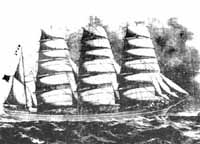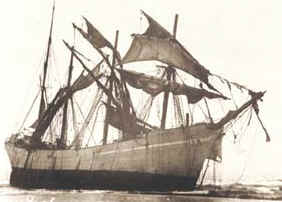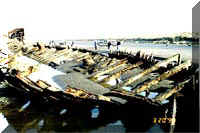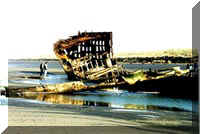By Thomas P. Iredale
Almost coincidental with the 100th anniversary year of the death in 1899 of the Cumbrian mariner and shipowner, after whom this ship was named, the Peter Iredale has revealed herself once more to the incredible stares of the people flocking to see her.
Built in 1890, among the last of the sailing ships built by Ritsons of Maryport, Cumbria, and side-launched into the River Ellen, this 4-masted steel barque of 2075 gross registered tons, was almost three hundred feet long, with royal sails above double-top and topgallant sails and one of the sleekest ships of her time. As part of the fleet belonging to P. Iredale & Porter Ltd of Liverpool, the Peter Iredale was mainly engaged in the cargo trade with the Americas and was a true "Cape Horner".
On that fateful night of the 25th of October 1906, she was making course for the Columbia River en route from Salina Cruz, Mexico for Portland, Oregon, with a 1.000 tons of ballast, when she was driven ashore by a fearful storm at Clatsop Beach, Port Adams. The impact of her grounding causing her to lose her upper spars, which came crashing down on the deck. None of the crew of 27 (including 2 stowaways) were injured and they were rescued by the lifeboat at Hammond. A Naval Court investigating the accident in November 1906 in Astoria, Oregon, cleared the Master, Captain G.A. Lawrence, of any blame in losing the ship.
The wreck became a major tourist attraction on the Pacific coast of Oregon and is possibly the most photographed shipwreck in the world. During the 93 years she languished in the surf, (and was also shelled by a Japanese submarine in WW2), she could only be seen at low tide, but as sand had covered most of her, only the stern was visible. In the winter of 1999, terrible storms caused a great deal of sand erosion at Clatsop Beach, removing hundreds of tons of sand and silt out of the wreckage.
David and Janice Crawford, who have lived about a mile away from the wreck site since 1966, said they have never before seen so much of the ship. "History uncovered." is how they put it.
Another local resident, Jean McKinney, a freelance maritime researcher at the Columbia River Maritime Museum in Astoria, Oregon, described it simply as "exciting". The event has attracted hundreds of people, curious to see the Peter Iredale in her rare, revealing state.
A hundred years ago in 1899, Peter Iredale died in Rock Ferry, across the River Mersey from Liverpool, England, after a long career totally linked with the sea - as a sailor, master mariner, supercargo and shipowner. Working up to a month before his death at 76, Peter Iredale eventually succumbed to "gout, chronic nephritis and exhaustion". With almost twenty sailing ships at his command during his heyday, cargoes of grain, timber, coal, nitrates and even railway lines for Australia, were carried by his ships between the hemispheres.
The same Pacific storms, which drove "his" ship into the beach at Clatsop, cleared her of sand a century later and resurrected her, in what may have been a fitting salute to the pioneering spirit of Peter Iredale and his contribution to maritime history in the era of sail.
![]()



